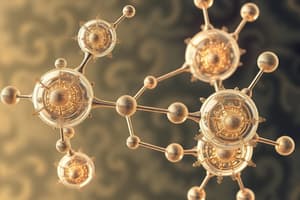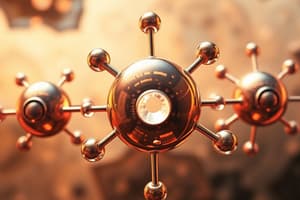Podcast
Questions and Answers
What is the key difference between polar and nonpolar covalent bonds?
What is the key difference between polar and nonpolar covalent bonds?
- Polar covalent bonds have more electrons than nonpolar covalent bonds.
- Nonpolar covalent bonds have unequal sharing of electrons, while polar covalent bonds involve equal sharing.
- Polar covalent bonds involve unequal sharing of electrons, while nonpolar covalent bonds involve equal sharing. (correct)
- Nonpolar covalent bonds are stronger than polar covalent bonds.
Why do polar molecules have the strongest intermolecular forces?
Why do polar molecules have the strongest intermolecular forces?
- Since they lack partial charges.
- Because they have a balanced distribution of charges.
- Due to their symmetrical structure.
- They exhibit dipole-dipole interactions. (correct)
Which type of bond is formed by sharing three pairs (six electrons) between two atoms?
Which type of bond is formed by sharing three pairs (six electrons) between two atoms?
- Single bond
- Double bond
- Triple bond (correct)
- Covalent bond
How can electronegativity and symmetry be used to predict polarity?
How can electronegativity and symmetry be used to predict polarity?
How do intermolecular forces affect the properties of substances like viscosity and boiling point?
How do intermolecular forces affect the properties of substances like viscosity and boiling point?
What is the strongest type of intermolecular force among the following?
What is the strongest type of intermolecular force among the following?
Flashcards are hidden until you start studying




